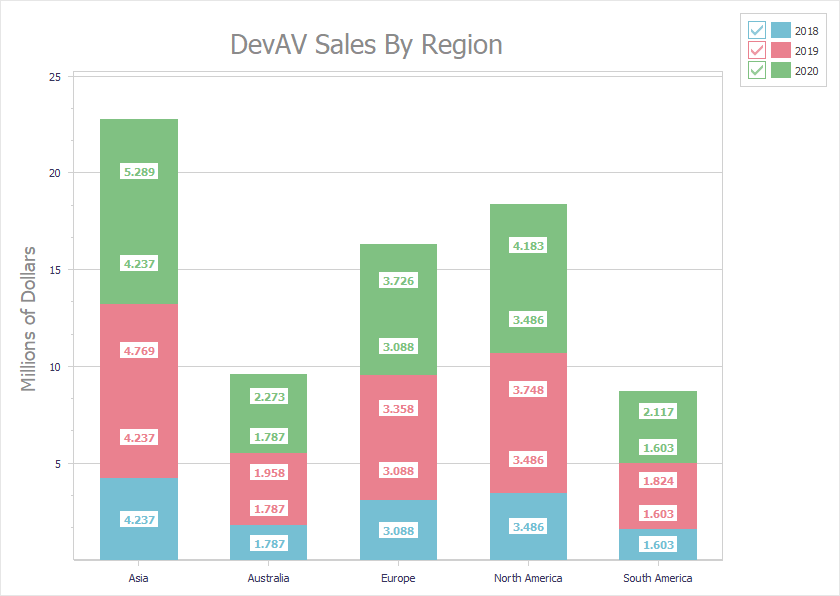TdxChartXYSeriesUnboundDataBinding Class
Stores data binding settings for an XY series in unbound data access mode.
Declaration
TdxChartXYSeriesUnboundDataBinding = class(
TdxChartSeriesUnboundDataBinding
)Remarks
An XY series is in unbound mode when its DataBindingType property is set to 'Unbound'. In this mode, you can call Points.Add methods to populate the series with data points. The ArgumentField and ValueField properties define data types of arguments and values in series data points, respectively.
The DataBinding property of an XY series references the TdxChartXYSeriesUnboundDataBinding class as a TdxChartSeriesCustomDataBinding object if the DataBindingType property of the series is set to 'Unbound'.
Note
You need to cast the DataBinding property to the TdxChartXYSeriesUnboundDataBinding class to access the ArgumentField and ValueField properties.
Code Example: Create Three Unbound Stacked Bar Series
The following code example creates three stacked bar series with identical appearance settings in unbound data access mode:
uses cxDataStorage; // Declares the TcxStringValueType class
// ...
var
AXYDiagram: TdxChartXYDiagram;
AXY2018Series, AXY2019Series, AXY2020Series: TdxChartXYSeries;
AStackedBarView: TdxChartXYSeriesStackedBarView;
ADataBinding: TdxChartXYSeriesUnboundDataBinding;
begin
dxChartControl1.BeginUpdate; // Initiates the following batch change
try
AXYDiagram := dxChartControl1.AddDiagram<TdxChartXYDiagram>('DevAV Sales By Region');
AXYDiagram.Title.Appearance.FontOptions.Size := 20;
AXYDiagram.Axes.AxisY.Title.Text := 'Millions of Dollars';
AXYDiagram.Axes.AxisY.Title.Appearance.FontOptions.Size := 14;
AXY2018Series := AXYDiagram.AddSeries('2018'); // Creates a new series with the caption "2018"
// Selects the unbound data access mode
AXY2018Series.DataBindingClass := TdxChartXYSeriesUnboundDataBinding;
ADataBinding := AXY2018Series.DataBinding as TdxChartXYSeriesUnboundDataBinding;
// Selects the string data type for arguments
ADataBinding.ArgumentField.ValueTypeClass := TcxStringValueType;
AXY2018Series.ViewClass := TdxChartXYSeriesStackedBarView; // Selects the Stacked Bar series View
AStackedBarView := AXY2018Series.View as TdxChartXYSeriesStackedBarView;
AStackedBarView.ValueLabels.Visible := True; // Displays value labels on bars
AStackedBarView.ValueLabels.TextFormat := '{V:0.000}'; // Changes the number display format
AStackedBarView.ValueLabels.Appearance.FontOptions.Bold := True;
AXY2018Series.Points.Add('Asia', 4.2372);
AXY2018Series.Points.Add('Australia', 1.7871);
AXY2018Series.Points.Add('Europe', 3.0884);
AXY2018Series.Points.Add('North America', 3.4855);
AXY2018Series.Points.Add('South America', 1.6027);
AXY2019Series := AXYDiagram.AddSeries; // Creates a new series with the default settings
AXY2019Series.AssignFrom(AXY2018Series); // Copies all settings from the "2018" series
AXY2019Series.Caption := '2019'; // Defines a different series caption
AXY2019Series.Points.Add('Asia', 4.7685);
AXY2019Series.Points.Add('Australia', 1.9576);
AXY2019Series.Points.Add('Europe', 3.3579);
AXY2019Series.Points.Add('North America', 3.7477);
AXY2019Series.Points.Add('South America', 1.8237);
AXY2020Series := AXYDiagram.AddSeries('2020'); // Creates a new series with the default settings
AXY2020Series.AssignFrom(AXY2018Series); // Copies all settings from the "2018" series
AXY2020Series.Caption := '2020'; // Defines a different series caption
AXY2020Series.Points.Add('Asia', 5.289);
AXY2020Series.Points.Add('Australia', 2.2727);
AXY2020Series.Points.Add('Europe', 3.7257);
AXY2020Series.Points.Add('North America', 4.1825);
AXY2020Series.Points.Add('South America', 2.1172);
finally
dxChartControl1.EndUpdate; // Calls EndUpdate regardless of the batch operation's success
end;
end;
